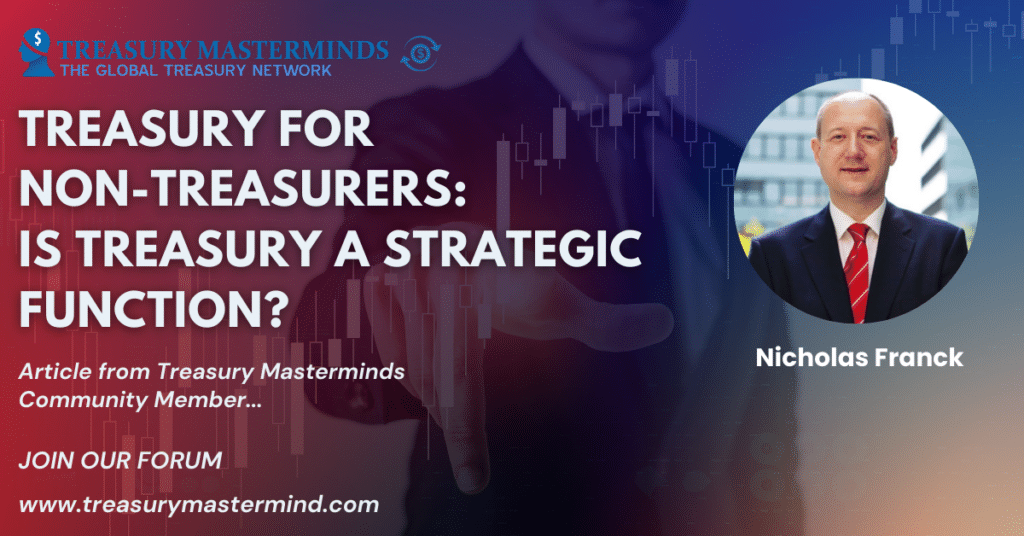
Treasury for Non-Treasurers: Is Treasury a Strategic Function?
We closed last week with the question: “Is Treasury a strategic function?” Ask 1,000 treasurers the question, 999 will say “Yes”. 🙄 I’m being unkind. There is no agreed definition of ‘strategic,’ so every function is strategic in some way or another. Let’s tighten that up. Here’s my definition: “A strategic Treasury: 1. Is one whose focus is on value-add for itself and, more importantly, for more than itself. It’s willing to have worse results if the results of the company or those of customers, suppliers, or anyone in the value chain increase more than the Treasury losses (or extra work and costs.) 2. Is proactive. It puts forward ideas for value creation without needing to be asked by higher management or other functions. 3. Differentiates itself from an operational treasury, which processes and is generally reactive, and from a tactical treasury, which, although still mainly a processing function, does innovate to some extent but only to improve its results, not others’. 4. (and this one might be surprising) Is one that has lower-level functions within it that are at the tactical and operational levels. Dreams without the ability to deliver are useless.” Many of you will find it unlikely that such functions exist. 😠I respectfully disagree and thank one of my first bosses at IBM, Ray Pillai, and ABB and Nokia at the height of their success for showing me that they do. 👠I was fortunate enough to help build IBM’s first Regional Treasury Centre, so I saw it develop from nothing into a world-class operation. Are many Treasuries strategic according to this definition? Answer: No, in fact, very few are. Trying to put some figures on this, research on the diffusion of innovation (a key requirement for proactivity) suggests that 2.5% of an average set of people or organisations are innovators. But Treasury operates within and surrounded by finance, a necessarily conservative environment, and many of its participants have an accounting background, where, again, necessarily, they are trained to be conservative. Many also operate within company and country cultures that don’t encourage risk-taking and bottom-up proactivity. For any of these reasons and more – that we will talk about in later articles – a much smaller figure is likely to be correct. In my experience, less than 1% of organisations meet all the criteria above. Early adopters are supposed to be 13.5% of the population. I think I think this figure for Treasury organisations that meet many but not all criteria is more likely to be between 5 and 10% for the same reasons. The rest (early majority, [34%+], late majority [34%+], and laggards [16%+] go from being tactical treasuries to operational ones. Note that these are high-level numbers, and if you concentrate on an individual Treasury, it can be the exception that proves the rule. Also, Treasury project teams and sub-functions can have different orientations. And all these can change at times and over time: If external cultures, context, material adverse impacts (‘Black Swans’), significant needs, key personnel or other aspects change, so does the Treasury orientation. Some become more strategic, some less. At a higher level, though, the numbers probably don’t change that much. Some go up and some down. Long-term, truly innovative Treasuries are rare, and so are fast followers. Working with strategic Treasuries These strategic Treasuries are the trendsetters. They are the customers that suppliers work with when developing new products. They face problems and learn how to control undesirable aspects of cutting-edge products. If they innovate frequently, they become good at spotting undesirable elements in advance and managing them. Other Treasuries don’t. Seduced by tales of success by others, they buy products and services but don’t realise the dangers until it’s too late. Current example: As Treasuries become increasingly automated, who’s left to design and implement change in a crisis? Why should non-Treasurers care? So, OK, it’s clear why a treasurer might care. But why should a non-treasurer care? Answer: Because a strategic Treasury will initiate change for the benefit of the whole organisation, working for you, the non-treasurer, and for those who will deliver maximum benefits for the company. As we’ll see in the next article, these benefits are substantial and translate into better financial results, freer budgets, and happier work environments. And best-in-breed Treasuries can communicate effectively with you in your language. You don’t have to add ‘gain treasury expertise’ to your list of priorities. Tactical Treasuries also work well with others. But they will not initiate. And they won’t be the driving force for improvement. They don’t add as much value as strategic Treasuries but instead help you achieve it. They are more business partners than value-added functions. How can you tell if a Treasury operation is strategic? Over time, non-treasurers see this difference. Non-treasurers realise they get more value out of strategic Treasuries – and vice-versa. Strategic Treasuries accumulate political capital, which translates into more staff, bigger budgets, and more opportunities for value-add. This last point is a big ‘tell’ for non-treasurers – like a poker tell that tells you what cards the player is holding. How do you recognise strategic or tactical Treasuries from the outside looking in? Look for those with large staff, resources and budgets compared to similar organisations or other back-office functions in the same organisation. The staff will seem happier and more motivated. They will be more flexible. They will try to see situations from your point of view. These are the strategic and tactical Treasuries. And remember: They do exist. Next article: What’s Treasury’s impact on business performance? To read the first series of this article, please check: Treasury for Non-Treasurers: What is Treasury? Join our Treasury Community Treasury Masterminds is a community of professionals working in treasury management or those interested in learning more about various topics related to treasury management, including cash management, foreign exchange management, and payments. To register and connect with Treasury professionals, click [HERE] or fill out the form below to get more information. Notice: JavaScript is…

Treasury expert’s insights: Payment hub implementation
This article is written by Nomentia Summary. A payment hub solution is a key technology to centralized cash management. Fragmented payment systems, manual payment processes, and the lack of real-time cash flow visibility pose significant challenges that can quickly lead to inefficiencies and risk management issues. In this article, based on our chat with treasury expert Pia Charron, we’re answering questions on how to implement a payment hub and what the best practices are payment hub implementation. We cover what a payment hub is in detail in this article, top 9 best payment hub solutions in 2024 here, and how to choose a payment hub solution here. As the financial landscape evolves ever more rapidly, many finance professionals are looking to implement a payment hub to streamline cash management processes and payment operations. To delve deeper into this topic, I had the privilege of interviewing Pia Charron, a lead consultant at Nomentia with over two decades of experience in treasury and cash management systems. With her extensive expertise, Pia provided invaluable insights into the intricacies of payment hub implementation and the key factors driving its success. Meet Pia Charron: A treasury expert Pia’s journey in the realm of treasury began over 20 years ago and with an extensive experience like that, there’s precious little she doesn’t know about implementing cash management and payment management systems. At Nomentia, she plays a pivotal role as a lead consultant, guiding clients through their cash management projects. Whether it is working with large multinational corporations or SMEs, Pia’s expertise spans various sectors, offering tailored solutions to meet each client’s unique needs. The role of payment hub in effective cash management Today’s finance professionals face increasing challenges from fragmented payment systems, manual processes, and lack of real-time visibility into cash flows. It’s well known that this can result in inefficiencies, errors, and difficulties in managing liquidity and risk effectively. As things stand, it’s no wonder that forward-looking finance professionals are considering implementing a payment hub that can centralize payment operations, automate manual tasks, and gain real-time visibility into financial transactions. During our chat, Pia emphasized the critical role these hubs play in enhancing efficiency and accuracy within cash management systems. By centralizing payment operations, businesses are able to significantly reduce errors and manual work while gaining better control over their financial processes. But success in payment hub implementation, as in so many other things, depends on having a clear understanding of what customers want and what they need. Understanding customer payment hub needs At the heart of payment hub implementation is the need for organizations to consolidate their payment operations. Instead of dealing with multiple banking platforms and disparate systems, a payment hub integrates all payment activities into a single, cohesive system. Central to any successful payment hub implementation is understanding how these diverse customer needs are recognized and fulfilled. Pia highlighted two primary categories of customer requirements: those seeking centralization and efficiency, and those aiming for visibility and control over their payment ecosystems. Whether it’s a multinational corporation or an SME, the customer’s goals dictate the approach to payment hub implementation. The payment hub implementation process Although each business has its own goals and requirements, all payment hub implementations start with the same situation; with an understanding of three key things: First, what goals the customer has for their payment operations; second, analyzing their current payment ecosystem and processes; and finally, collaborating to devise a strategy on how the customer’s goals can be achieved through the implementation of a payment hub: Payment hub requirements: To get your payment hub up and running, you have to start by defining the specific requirements for the payment hub implementation, including master data, required bank connections, necessary user roles, and security controls. Payment hub system setup and configuration: Once the scope of your payment hub is settled, next up is setting up and configuring your payment hub system based on defined requirements. Payment hub testing: Before being deployed, your newly set up payment hub requires rigorous testing to ensure the system functions as intended and meets requirements. Payment hub user training: The key component to effective payment hub implementation is training the admin users who can best communicate and engage internal stakeholders and train payment hub end-users on how to use it effectively. Payment hub deployment: Once the testing of your new centralized payment hub is done and users are trained, it’s time to go live. Navigating through the implementation process of a payment hub requires a systematic approach. Pia outlined the various steps involved, starting from defining customer requirements to system setup, testing, training, and deployment. Each stage is important and should be meticulously planned and executed in collaboration to ensure payment hub implementation success. Payment hub implementation challenges and solutions Despite the benefits, payment hub implementation comes with its own set of challenges. As Pia emphasized during our interview, these challenges often stem from the complexity of integrating the payment hub with existing systems and processes, which can require meticulous planning and coordination. Other common payment hub implementation challenges include: Resistance to change: Change can be scary so, it’s not entirely unheard of that employees may resist adopting new processes and technologies, which can lead to implementation delays. Scope creep: Once initial plans for payment hub implementation are made, the project scope may expand beyond the initial plans. This can, if not carefully managed, lead to additional costs and increased timelines. Payment hub customization complexity: As the payment hub is an important system that needs to support business payment operations comprehensively, customizing or tailoring the payment hub to meet specific business needs often comes up. It’s vital to be mindful of the fact that these emergent needs can be complex and time-consuming, while not serving the initially defined goals of the payment hub implementation project. Resource constraints: The limited availability of skilled resources, both internally and externally, can hamper the payment hub implementation process and lead to delays or suboptimal outcomes. It is always wise to be aware of possible pitfalls in payment hub implementation, as they can…
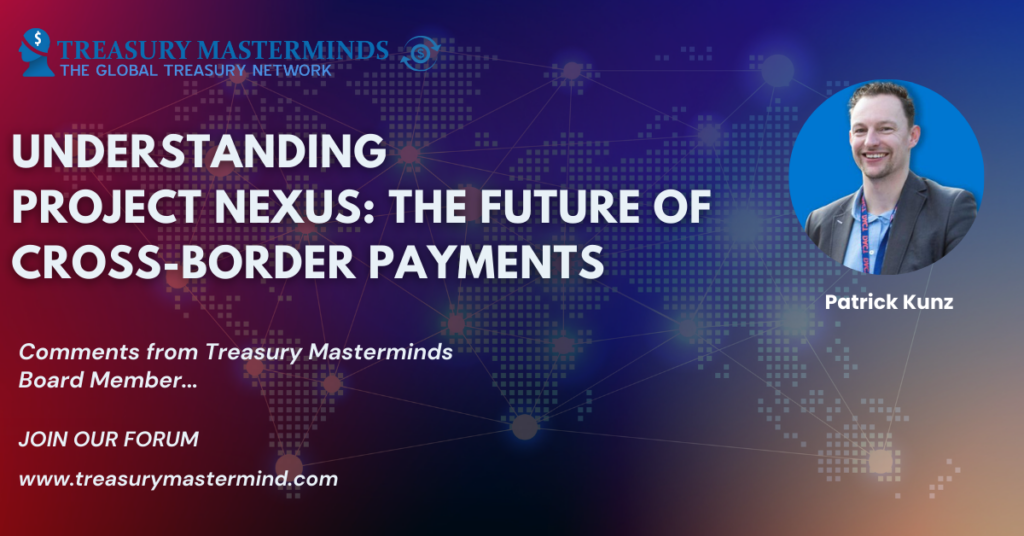
Understanding Project Nexus: The Future of Cross-Border Payments
In an increasingly interconnected global economy, the need for efficient, secure, and cost-effective cross-border payment systems has never been more pressing. Enter Project Nexus, an initiative spearheaded by the Bank for International Settlements (BIS) with the ambitious goal of revolutionizing the way cross-border payments are conducted. As treasury professionals, it’s crucial to stay informed about such groundbreaking projects that have the potential to reshape the financial landscape. Let’s delve into what Project Nexus is, its objectives, and what it means for the future of international finance. What is Project Nexus? Project Nexus is a collaborative effort initiated by the BIS Innovation Hub to create a framework for linking multiple national instant payment systems (IPS) into a unified cross-border payments network. The primary aim is to significantly reduce the time, cost, and complexity involved in transferring money across borders. This initiative leverages the capabilities of existing IPS and integrates them into a cohesive, interoperable system that can facilitate near-instantaneous cross-border payments. Objectives of Project Nexus The overarching objectives of Project Nexus are: How Does Project Nexus Work? Project Nexus builds on the existing infrastructure of national instant payment systems (IPS) by establishing a standardized protocol for interoperability. Here’s a simplified overview of the process: Real-World Examples and Use Cases Several pilot projects and collaborations are already demonstrating the potential of Project Nexus. Here are a few notable examples: 1. Singapore-Thailand Linkage One of the earliest and most prominent examples is the linkage between Singapore’s PayNow and Thailand’s PromptPay. This initiative, facilitated by the Monetary Authority of Singapore (MAS) and the Bank of Thailand (BOT), allows users in both countries to transfer funds using just the recipient’s mobile number. This cross-border linkage offers near-instantaneous transfers and transparent fees, showcasing the practical benefits of Project Nexus. 2. Europe-Asia Connectivity Another example is the collaboration between the European Central Bank (ECB) and the Hong Kong Monetary Authority (HKMA) to explore linking their respective IPS. This initiative aims to streamline transactions between Europe and Asia, providing faster and cheaper payment options for businesses and individuals alike. 3. ASEAN Region Integration The ASEAN region, with its diverse economies and high volume of cross-border trade, is a prime candidate for Project Nexus. Efforts are underway to connect IPS across ASEAN countries, facilitating seamless transactions within this economically vibrant region. Implications for Treasury Professionals For treasury professionals, the implications of Project Nexus are profound: Future Outlook Project Nexus represents a significant leap forward in the realm of cross-border payments. As more countries and payment systems join this initiative, the network effects will amplify, leading to even greater efficiency, cost savings, and accessibility. For treasury professionals, staying abreast of these developments and understanding how to leverage them will be key to maintaining a competitive edge in an increasingly globalized marketplace. Insights from Treasury Experts We thought it would be valuable to get perspectives from Treasury professional, Patrick Kunz, who is also Treasury masterminds board member Patrick Kunz, CEO and Founder of Pecunia BV Treasury and Finance, Comments Instants payments are nice but not a need for treasury, more often a nice to have. Besides the obvious savings mentioned in the article. Instant payments cross border and cross currency would be a game changer. More often problems in payments and settlement arise when it is cross border and cross currency. Settlement times of 1-2 days are still common. even though it’s 2024, not of this time anymore. Especially if money is sent wrongly or “lost in limbo” by the bank. The questions of where my money during the transfer is is solved by connecting instant payment schemes. Treasurers want this now! Timelines and connectivity between schemes will take time though but every steps towards it is a win. The use cases mentioned are great examples of treasurers cross border payment struggles which would be solved. In conclusion, Project Nexus is poised to transform the landscape of cross-border payments, making them faster, cheaper, and more transparent. By embracing this innovation, treasury professionals can enhance their operational efficiency, manage liquidity more effectively, and ultimately support their organizations’ global growth objectives. Also Read Join our Treasury Community Treasury Masterminds is a community of professionals working in treasury management or those interested in learning more about various topics related to treasury management, including cash management, foreign exchange management, and payments. To register and connect with Treasury professionals, click [HERE] or fill out the form below to get more information. Notice: JavaScript is required for this content.
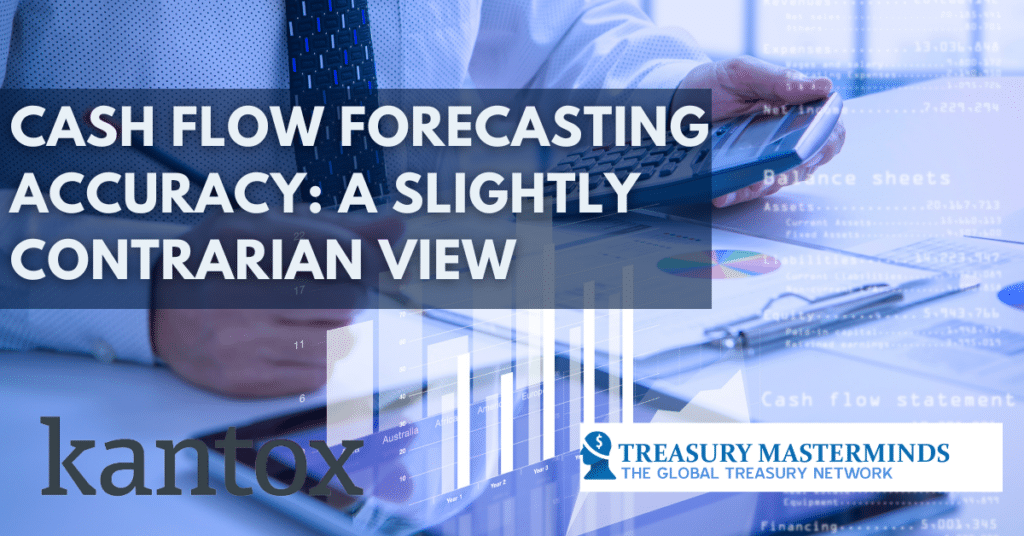
A Slightly Contrarian View On Cash Flow Forecasting Accuracy
This article is written by Kantox Time after time, FX management surveys confirm treasurers’ concerns with the degree of accuracy in their cash flow forecasts. In our own sample measurement, this concern is given more weight than potential episodes of high FX volatility or shifting interest rate differentials between currencies. Worries about cash flow forecast accuracy are easily understood given the current uncertainty in financial markets. As a corporate treasurer, the last thing you need is to be caught off-guard in terms of your company’s funding needs, a point recently made by investor Warren Buffett. No one would seriously challenge that assessment. Yet, when it comes to currency management, the importance of having accurate cash flow forecasts is overstated. Let us see this in more detail. Cash flow forecasting in hedging programmes There are three main FX cash flow hedging programs: Here’s our point: the degree of forecasting accuracy is not a pressing concern in any of these programs. This is almost obvious in the case of micro-hedging programs for firm sales and purchase orders, which are very popular in the Travel industry and others where companies frequently update their prices. The reason is clear: a firm commitment is a legally binding agreement. Its probability of occurrence is very high. Arguably, it is not even a forecast at all. Forecasted exposures and FX hedging: layering Things get more interesting in hedging programs where the FX exposure is unmistakably in the shape of cash flow forecasts. Layered hedging programs are used by companies that desire to smooth out the hedge rate over time. Consider a linear layered hedging program with 12-month granularity, one of the most used. To achieve the necessary commonality between hedge rates, currency hedges in layers of 8.3% are applied, month after month, to the forecasted cash flows (100%/12 = 8.3%). For example, if a forecasted exposure with a January 2024 value date needs to be 100% hedged at the end of December 2023, by the time we reach the end of August 2023, that particular forecasted exposure will have received 8 layers of hedges. And accuracy will be required for less than 70% of the forecast (8.3% x 8 = 66.6%). This is well within the range of what is considered achievable by most standards. Forecasted exposures and FX hedging: protecting the budget rate In companies whose main goal is to protect the FX rate used in pricing during a particular campaign, risk managers may feel tempted to hedge most of the forecasted exposure at the start of the campaign. While this allows them to remove the inherent pricing risk of a ‘catalogue-based’ model, it does require a high degree of forecasting accuracy. The solution is to set a program that guarantees a ‘worst-case scenario’ FX rate equal to the budget rate used in pricing. This rate can be protected with conditional orders that are set, for example, at 1%, 2% and 3% to the budget rate, each for a third of the exposure.The worst-case scenario rate, in turn, is set at a level that includes a buffer to the spot rate. What do we gain from this buffer? Flexibility. As time goes by and no hedges are executed on the back of the budgeted exposure, cash flow forecasts are continuously updated. With an added bonus: managers can leverage the information from incoming firm sales/purchase orders to fine-tune their forecasts. Automation requirements The operational complexities of the FX hedging programs outlined above make it impossible to manually execute them without error. Here are some examples of why automation is necessary when it comes to managing FX risk: Do you wish to set yourself free from the constraints of super-accurate cash flow forecasts when managing FX risk? Currency Management Automation solutions allow you to do just that, while the Treasury team seamlessly executes the entire FX workflow. All the while, the most precious asset of all—time—will be at your disposal to further improve those irksome forecasts. Also Read Join our Treasury Community Treasury Masterminds is a community of professionals working in treasury management or those interested in learning more about various topics related to treasury management, including cash management, foreign exchange management, and payments. To register and connect with Treasury professionals, click [HERE] or fill out the form below to get more information. Notice: JavaScript is required for this content.
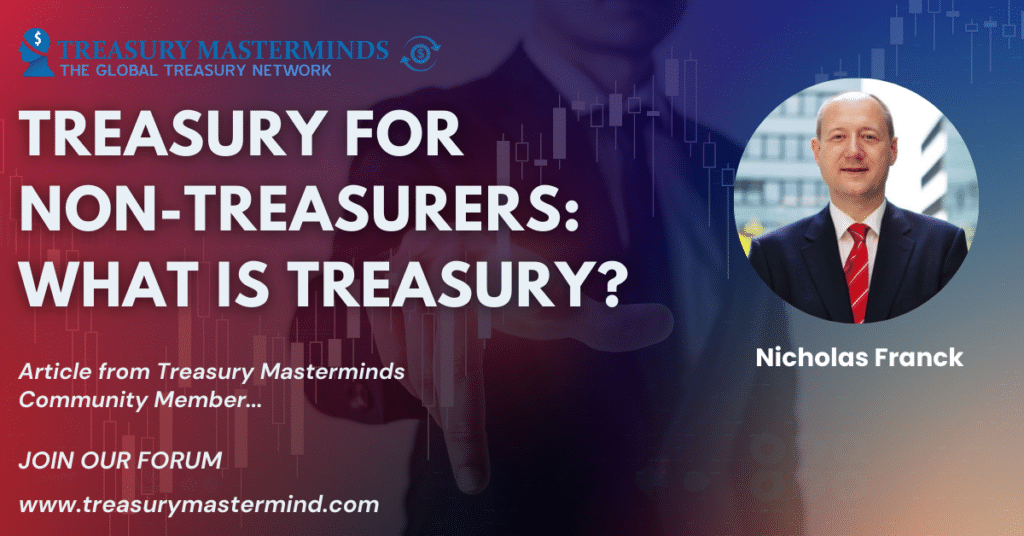
Treasury for Non-Treasurers: What is Treasury?
Treasury for Non-Treasurers: Article 1 – What is Treasury? Summary: 4 pillars, simple but with massive implications.

Organizations Shift Deposits to Large Banks Amid Economic Uncertainty
In a proactive response to the challenging economic environment, 45% of organizations have moved their deposits to large banks, according to the 2024 AFP Liquidity Survey. This strategic shift aims to enhance financial security by leveraging the stability of systemically important financial institutions. Additionally, 35% of organizations diversified their deposits among multiple banks to mitigate counterparty risk. The survey also revealed an 8% increase in cash holdings within the U.S. over the past year, with 44% of treasury professionals reporting this rise. Larger organizations prioritize safety in their investment policies, with 69% emphasizing this, compared to 58% of smaller organizations. Despite rising interest rates, over two-thirds of respondents noted that their companies’ earnings credit rate did not keep pace. The overall relationship with banks remains crucial, as 89% of professionals consider it the most important factor in selecting a banking partner, surpassing credit quality and counterparty risk. Money market fund reform has had minimal impact, with only 4% of allocations in prime or diversified funds. However, 32% are adopting a “wait and see” approach regarding upcoming regulatory changes. The survey underscores the importance of robust banking relationships and prudent liquidity management in navigating economic challenges. Counterparty Risk in Corporate Cash Management From a corporate perspective, counterparty risk—the risk that the bank holding the deposits might default—is a significant concern. In the current volatile economic environment, this risk has become more pronounced, prompting organizations to reassess their banking strategies. 1. Diversification to Mitigate Risk By spreading deposits across multiple banks, corporations aim to reduce their exposure to any single financial institution’s potential failure. This strategy ensures that a company’s liquidity is not overly dependent on one entity, thereby safeguarding its cash reserves. 2. Preference for Large Banks Larger banks are often deemed more stable due to their substantial capital reserves, regulatory oversight, and systemic importance. These institutions are typically considered too big to fail, which provides an added layer of security for depositors. The recent trend of moving deposits to these banks reflects a strategic move to enhance financial stability. 3. Monitoring and Evaluation Continuous monitoring of the financial health of banking partners is crucial. Corporations are increasingly relying on credit ratings and other financial metrics to evaluate the solvency and reliability of their banks. This ongoing assessment helps in making informed decisions about where to place their deposits. 4. Regulatory Environment Changes in banking regulations can impact counterparty risk. Corporations need to stay informed about regulatory developments that may affect the stability of their banking partners. The evolving landscape of money market fund reforms and other financial regulations requires a proactive approach to risk management. 5. Balancing Yield and Safety While seeking to maximize returns on their cash reserves, corporations must balance this objective with the need for safety. Higher yields often come with higher risk, and in uncertain times, the focus tends to shift more towards preserving capital than earning high returns. Insights from Treasury Experts We thought it would be valuable to get perspectives from Treasury professional, Jessica Oku, who is also Treasury masterminds board member Jessica Oku, Director of Fund Development at Women’s Health Coalition Canada, Comments A shift of 45% of organizations moving their deposits to large banks is expected. This trend is driven by the safety net provided by large banks, attributed to their substantial balance sheet size, robust risk management frameworks, and strong corporate governance, which are crucial for treasurers aiming to protect their assets. Additionally, 35% of organizations are diversifying their deposits among multiple banks to mitigate counterparty risk, which is also expected. This is because counterparty risk has become a growing concern. Spreading deposits helps to protect your organization’s liquidity from the potential failure of any single institution. It is also crucial to choose institutions with top ratings to further secure your funds. Larger organizations prioritize safety in their investment policies shows that there’s a clear trend towards capital preservation over higher returns. Invariably, these organization’s risk appetites will be clearly reflected in their policies and affect investment decisions. Which is understandable, especially in the current economic climate. Conclusion In conclusion, counterparty risk is a critical factor in corporate cash management strategies. By diversifying deposits, choosing stable banking partners, and staying vigilant about regulatory changes, organizations can effectively manage this risk and ensure the security of their financial assets. Also Read Join our Treasury Community Treasury Masterminds is a community of professionals working in treasury management or those interested in learning more about various topics related to treasury management, including cash management, foreign exchange management, and payments. To register and connect with Treasury professionals, click [HERE] or fill out the form below to get more information. Notice: JavaScript is required for this content.
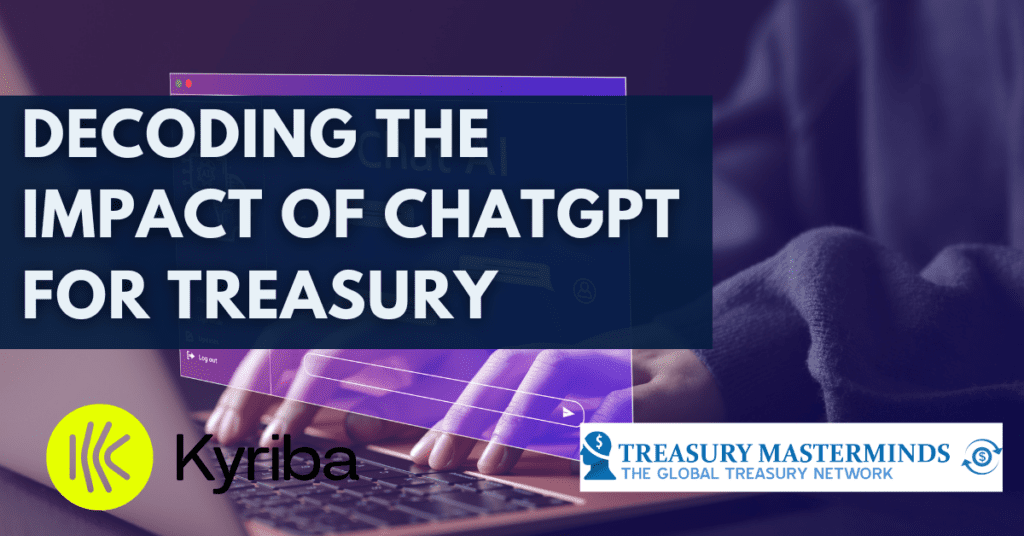
Decoding the Impact of ChatGPT for Treasury
This article is written by Kyriba Generative AI, represented by groundbreaking models like ChatGPT, is poised to revolutionize treasury management. However, its integration brings forth a spectrum of implications, from promising opportunities to potential risks. We highlight the potential benefits and risks associated with integrating generative AI in treasury and finance operations. Exploring Generative AI Generative artificial intelligence (AI) is a subset of artificial intelligence technology. Unlike traditional AI systems that are often limited to specific tasks or domains, generative AI models are designed to generate novel outputs, including text, audio, images, and even entire virtual environments. Put simply, these models are usually trained on large datasets to learn patterns and relationships within the data. This allows generative AI models to create new content that is coherent and relevant to the input provided.. One of the main characteristics of generative AI is its ability to produce diverse and realistic outputs that mimic human creativity and intelligence. Although it has the potential to automate manual tasks and improve efficiency, there are concerns about fake or misleading content and the potential for misuse, like deepfakes. ChatGPT Is a Pioneer in the GenAI Space A prominent example of generative AI in action is ChatGPT, developed by OpenAI. Since its launch, ChatGPT has garnered widespread acclaim, reaching 180.5 million users by March 2024. OpenAI and ChatGPT gained further notoriety by recently partnering with Microsoft for a multi-year alliance valued at $10 billion. Google has also taken notice; even though ChatGPT is not a search engine, it is already being viewed as competition for the online search giant. Google’s management has developed a chatbot of its own, though in a recent demo, it made a mistake that has already cost the company $100 billion in market value. What GenAI Means for Treasury GenAI, including ChatGPT, offers a range of new options for treasury teams, including the ability to ask questions of your treasury data – typed or by voice – as well as build new reports, queries, dashboards and even new programming and scripts. The biggest challenge for treasury teams is how to manage GenAI in a secure and safe manner. Different organizations will have different policies around the use of tools such as ChatGPT, including when open source language models can be used versus closed models such as ChatGPT Enterprise. To be responsible to all their customers, including those organizations that prohibit the use of ChatGPT altogether for their finance teams, most treasury system providers will not (and arguably should not!) embed ChatGPT directly into their software platforms. Rather they are opening their data models through APIs to make treasury data available to GenAI tools – which allows treasury teams to make their own choices about what, if any, GenAI tools they integrate into their treasury processes. For those that choose to introduce ChatGPT and similar tools into their treasury operation, here are examples – both good and scary – where we have seen GenAI increase its relevance for treasury: Payments Fraud Detection It’s been well documented that AI is being used regularly for both payments fraud and payments fraud prevention. Generative AI has now become the latest tool in fraudsters’ arsenals – making it a ‘scary’ scenario for treasury teams to combat. Cybercriminals are using generative AI tools–including ChatGPT–to help craft sophisticated phishing messages. There has been a 1,265% increase in malicious phishing emails since Q4 2022. Check Point, another cybersecurity firm, noted that using ChatGPT helped it create an end-to-end social engineering campaign from phishing emails all the way to embedded malware within an email attachment. The result was disturbingly convincing and confirmed that GenAI tools have lowered the bar for code generation, making it easier than ever for bad actors to attempt fraud. In response, cybersecurity experts all say the same thing: use automated systems to detect and prevent cyberattacks at machine speed. In treasury, this presents an opportunity to use AI in the payment process to detect suspicious payments, using adversarial networks to identify payment anomalies compared to an organization’s own payment history. While this is an example of GenAI being used for nefarious purposes, embedding a closed AI model to use only an organization’s own payment data to identify potential fraudulent payments is a great way to use AI to fight the AI employed by fraudsters. Enhancing Excel with AI Imagine a world where generative AI technologies seamlessly integrate with essential business tools, transforming traditional treasury management systems without disrupting existing structures. This vision is now a reality with Excel, supercharged with AI tools like ChatGPT and Copilot through OpenAI’s partnership with Microsoft. This integration not only enhances workflows with secure and streamlined interactions but also revolutionizes how data is managed and presented. Excel’s AI-powered features offer a GenAI function to engage with your data, capturing insights from both internal models and external sources. With Copilot, users can effortlessly create complex and easy-to-read spreadsheets. Need an extra column? Copilot will create it. Forgot that unique combination of formulas? Copilot has you covered. ChatGPT’s large language model unifies the data you need, while Copilot formats it into the most impressive spreadsheet you’ve seen. Microsoft addresses automation and data security concerns with Appsource store’s treasury apps, which automate the secure delivery of data into your spreadsheets. These embedded apps allow data to be queried from the cloud and presented directly into your spreadsheet. Simply sit back and enjoy the AI ride as your treasury management capabilities become more efficient and secure. Bank Payment Formats with AI One of the most challenging capabilities for both finance and IT teams is the bank payment format transformation process. This difficulty comes with the multitude of format variations banks require, making a standard such as XML ISO20022 PAIN v9 into more of a guideline with sometimes dozens of different file format requirements, even within the same bank. ChatGPT becomes a great solution to build these unique file format customizations on the fly for a payments system user or the IT professional tasked with updating the file delivery from their ERP to the bank. The ERP or treasury system exposes,…

HSBC Partners with Visa to Develop Zing International Money App
In a significant move towards enhancing digital financial services, HSBC has teamed up with Visa to launch the Zing international money app. This collaboration marks a strategic effort by both financial giants to simplify and innovate cross-border transactions for consumers globally. Streamlining Cross-Border Payments The Zing app aims to streamline the often complex and time-consuming process of international money transfers. By leveraging Visa’s robust payment network and HSBC’s extensive global reach, the app promises users a seamless and efficient experience. This initiative comes at a time when the demand for convenient and cost-effective digital payment solutions is rapidly increasing worldwide. Key Features and Benefits Market Impact and Future Prospects This collaboration underscores HSBC’s commitment to digital transformation and innovation within the financial services sector. By harnessing Visa’s technological capabilities and HSBC’s extensive market presence, the Zing app is positioned to capture a significant share of the rapidly growing digital payments market. Moreover, the launch of Zing reflects broader industry trends towards enhancing digital banking experiences and meeting the evolving needs of consumers in an increasingly interconnected world. As more consumers opt for digital solutions over traditional banking methods, partnerships like the one between HSBC and Visa are crucial for staying competitive and meeting customer expectations. Insights from Treasury Experts We thought it would be valuable to get perspectives from Treasury professional, Lorena Pérez Sandroni, who is also Treasury masterminds board member Lorena Pérez Sandroni, Head of Treasury at PayU GPO, comments The collaboration between HSBC and Visa indeed represents a strategic move that capitalizes on their combined expertise. By leveraging HSBC’s extensive experience in banking and payments alongside Visa’s open banking technology, they aim to create a seamless and secure international money app. This collaboration is crucial for the fintech companies journey to empower people worldwide with easy-to-use financial services. From my perspective, transferring money should be as straightforward as sending a text message, and cost-effectiveness is crucial. While traditional methods still dominate in some regions, not mentioning the restrictions and regulatory aspects in complex countries. Partnerships like this one can drive innovation and expand the possibilities for users. It’s exciting to witness how this collaboration will impact the global financial landscape. What is clear to me is that traditional banking and fintech partnerships are becoming increasingly prevalent, signaling a dynamic shift in the industry and the allocation of resources. This partnership reinforces the idea that traditional banking and fintech collaborations are here to stay!! Conclusion The partnership between HSBC and Visa to develop the Zing international money app represents a pivotal moment in the evolution of digital financial services. By combining their expertise and resources, both companies aim to redefine how individuals and businesses conduct cross-border transactions, offering greater convenience, transparency, and security. As the app rolls out globally, it will be interesting to observe how it influences the digital payments landscape and sets new benchmarks for customer experience in international banking. For consumers seeking efficient, reliable, and user-centric financial solutions, Zing promises to be a compelling option in the ever-expanding realm of digital banking. Also Read Join our Treasury Community Treasury Masterminds is a community of professionals working in treasury management or those interested in learning more about various topics related to treasury management, including cash management, foreign exchange management, and payments. To register and connect with Treasury professionals, click [HERE] or fill out the form below to get more information. Notice: JavaScript is required for this content.

AI for Fraud Detection: The Complete Guide
This article is written by Trustpair After rising fraud attempts in the 2010s, J.P. Morgan implemented an AI detection system. The bank created a machine learning algorithm to track live transactions and identify anomalies (even at scale). Since it was developed, JP Morgan has reported ‘lower levels of fraud, a better customer experience, and a reduction in false positives’. What is AI in fraud detection? Being widely accessible, but without a set guide-book has caused the perfect storm of misuse in AI. Bad use cases have tarnished the reputation of artificial intelligence, and many won’t know that there are actually plenty of AI applications for good. For example, AI algorithms can be applied to detect bank account changes, classify how suspicious these changes are, and detect threats of fraud. It’s one of the key finance and accounting trends for 2024! AI in fraud detection typically refers to a range of machine learning technologies. Machine learning works by applying a set of rules (known as an algorithm) to a scenario to make a decision. In this case, decide whether there is a threat of fraud or not. But the great advantage is that these rules evolve over time as technology feeds more information. AI “learns” from previous scenarios, and gets more and more accurate over time. Some examples of machine learning technology include: How does AI work to detect fraud? There are several steps for fraud detection that AI is involved with: What are the benefits of AI in fraud detection? A recent study by PWC and the Bank of England found that, despite all the potential cases for misuse, AI is more effective at fraud detection than manual controls. It’s obvious, then, that compared to no controls at all, AI provides a significant advantage to organizations in their fight against fraud. There are several key benefits, including: Dynamic rules Before AI, fraud detection strategies relied on applying static rules to data in order to find anomalies. But this could cause inaccuracies and false positives, since the rules never evolved unless the entire algorithm was changed. Instead, AI learns from itself, setting dynamic rules that change with the circumstances. For example, an email sorting platform might evolve its rule for categorizing junk emails once it discovers ‘off-brand’ domains. After learning that an email from google.com has a high likelihood of being spam, the AI platform can start categorizing all typo’d domain names into the junk folder. And this personalization can be scaled up to thousands of customers and vendors each month. By applying dynamic rules over pre-defined rules, companies using AI can benefit from higher accuracy. With fewer risks of false positive results, they’ll also keep the user experience intact, generating less friction within the sales process. Real-time Prior to the adoption of AI for fraud detection, companies were faced with employing a full time statistician to continuously analyze for threats. Not only was this a costly venture, but it relied on this individual not making manual errors, and working quickly. This left companies at a significant disadvantage: they couldn’t scale up and maintain the same levels of oversight. But with AI algorithms working in real-time, organizations can benefit from scale without incurring the same costs. This leads to further benefits when suspicious activities are detected, since AI algorithms can instantly block, freeze, or protect their accounts and report back to team members instantaneously. Having this all completed while continuing to assess more data in the background makes AI the multi-tasker of the times. Long term cost optimization It’s no secret that employing AI to prevent and detect fraud can be a costly investment. But with its heightened levels of accuracy, speed, and ultimate success, AI might ultimately provide long-term saving. That’s due to the lower likelihood of realized fraud events. By effectively preventing cases of fraud, companies face fewer reimbursements, fewer embarrassing reputational problems, and a reduced risk of fines for non-compliance. It can be compared to insurance, since you never really know if you’ll need it. But with 96% of US companies targeted at least once in 2023, it’s a question of when, not if. Wouldn’t you rather invest in order to be better protected against fraud? What are the types of fraud AI can detect? One of the best use cases for AI in fraud detection is to prevent payment fraud, which Sade Telecom, a construction company, experienced first hand. It occurred when the company’s accounting department received a letter requesting to change the payment details of one of their well-known suppliers. They had already received the accompanying invoice, so simply input the new account number and routing code, and off the payment went. Except for the fact that three weeks later, Sade Telecom received another notice from their supplier: a warning that their most recent invoice had become overdue. After some investigation, they realized that the letter was fake and that they had in fact paid the latest invoice to fraudsters. Having suffered significant financial losses, Sade Telecom turned to Trustpair. We use a proprietary hello@thesearchcure.com algorithm as part of our payment fraud prevention platform, which continuously checks account details with external databases to ensure they are correct. And when suspicious activity is detected, we automatically block payments to ensure your organization has all the time they need to investigate. Some of the other types of fraud that AI can detect include: What are the challenges of using AI in fraud detection? Being open about the key challenges of using AI in fraud detection will support companies in applying the right systems, practices and procedures to make the investment of their AI technologies effective. The two top challenges are: Black box Many AI algorithms are created in something known as a black box, which effectively hides its decision-making process. This means that AI lacks transparency, can cause huge trust problems when errors occur, and might be hard to effectively control. Black boxes are also at the crux of many of the morality arguments around AI; after all, if you can’t monitor how it’s being…